Fake News: Meaning- Concept and Consequence in Digital Media- KIT311
VerifiedAdded on 2023/01/23
|14
|4237
|27
Essay
AI Summary
This essay, prepared for a Social and Cultural Issues of Interactive Digital Media course, critically evaluates the phenomenon of fake news. It defines fake news as deliberately misleading information spread through various media, including social media, traditional media, and digital platforms, with the intent to misinform and cause harm. The essay explores concepts like "Yellow Journalism" and "Checkbook Journalism" as historical precursors. It then delves into demographic and social factors influencing the spread of fake news, such as age, education level, and political orientation. The role of digital media, particularly social media and social bots, in disseminating misinformation is analyzed, including how algorithms and bot activity amplify the reach of fake news. The essay also discusses the evolution of news distribution, the impact of social bots, and the challenges in identifying credible sources in the digital environment. The assignment highlights the interplay between news publishers, consumers, and advertisers within the digital media landscape and discusses the impact of digital media and social bots in spreading false information.
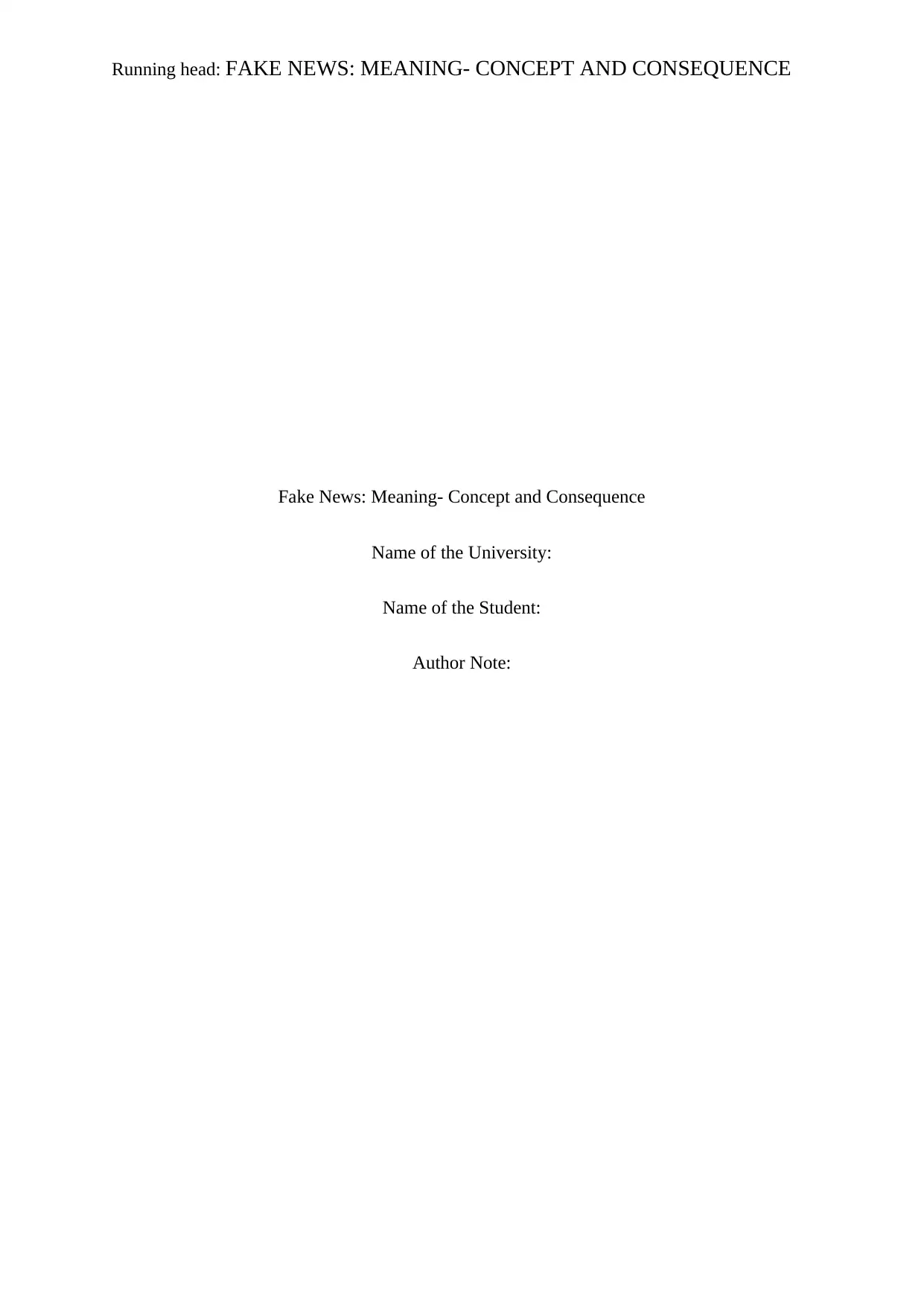
Running head: FAKE NEWS: MEANING- CONCEPT AND CONSEQUENCE
Fake News: Meaning- Concept and Consequence
Name of the University:
Name of the Student:
Author Note:
Fake News: Meaning- Concept and Consequence
Name of the University:
Name of the Student:
Author Note:
Paraphrase This Document
Need a fresh take? Get an instant paraphrase of this document with our AI Paraphraser

1Fake News: Meaning- Concept and Consequence
Fake news or Pseudo news are information or disinformation or hoaxes deliberately
spread out with the intention to mislead and misguide the public. These are spread via both
traditional and broadcast media. Social media also takes a huge role in spreading the
misinformation. Fake news are made, published and spread with the motive to hoax the
readers or to damage the reputation of an agency or organisation or a person or an entity, or o
gain politically or financially (McNair. 2017). The emergence and dominance of social media
has increased the spread of fake news and has given rise to the concepts of “Yellow
Journalism” and “Check book Journalism”.
Yellow Journalism is a form of journalism that spreads misinformation or distort the
real news in order to get public attention. They usually come up with shocking headlines to
gain the public attention and increase their selling and exaggerate the existing news creating
false notion regarding something. They spread what informally is called, rumours but in a
formal, believable way. The yellow journalism was much famous during the 1900s in New
York. The front page of the newspapers were the important ones, which included various
scandals regarding the sports, political or visual world. They used bold and coloured
illustrations and the reported information or stories were published anonymously or unnamed
sources (Cunha et al. 2018). The term came at the time when the technological invention was
in rise and the technology made newspaper got cheaper and it got its name from the
American gilded age. The essential characteristics of these newspapers were,
The news were printed in huge block letters to get the attention and to scare he people
and most of the times they were not even important.
The newspapers were usually consisted with many pictures.
They included many comical contents and portrayed the political icons in cartoon
characters. Though this is has now become much common but at that point of time,
they were the emerging concepts.
Fake news or Pseudo news are information or disinformation or hoaxes deliberately
spread out with the intention to mislead and misguide the public. These are spread via both
traditional and broadcast media. Social media also takes a huge role in spreading the
misinformation. Fake news are made, published and spread with the motive to hoax the
readers or to damage the reputation of an agency or organisation or a person or an entity, or o
gain politically or financially (McNair. 2017). The emergence and dominance of social media
has increased the spread of fake news and has given rise to the concepts of “Yellow
Journalism” and “Check book Journalism”.
Yellow Journalism is a form of journalism that spreads misinformation or distort the
real news in order to get public attention. They usually come up with shocking headlines to
gain the public attention and increase their selling and exaggerate the existing news creating
false notion regarding something. They spread what informally is called, rumours but in a
formal, believable way. The yellow journalism was much famous during the 1900s in New
York. The front page of the newspapers were the important ones, which included various
scandals regarding the sports, political or visual world. They used bold and coloured
illustrations and the reported information or stories were published anonymously or unnamed
sources (Cunha et al. 2018). The term came at the time when the technological invention was
in rise and the technology made newspaper got cheaper and it got its name from the
American gilded age. The essential characteristics of these newspapers were,
The news were printed in huge block letters to get the attention and to scare he people
and most of the times they were not even important.
The newspapers were usually consisted with many pictures.
They included many comical contents and portrayed the political icons in cartoon
characters. Though this is has now become much common but at that point of time,
they were the emerging concepts.
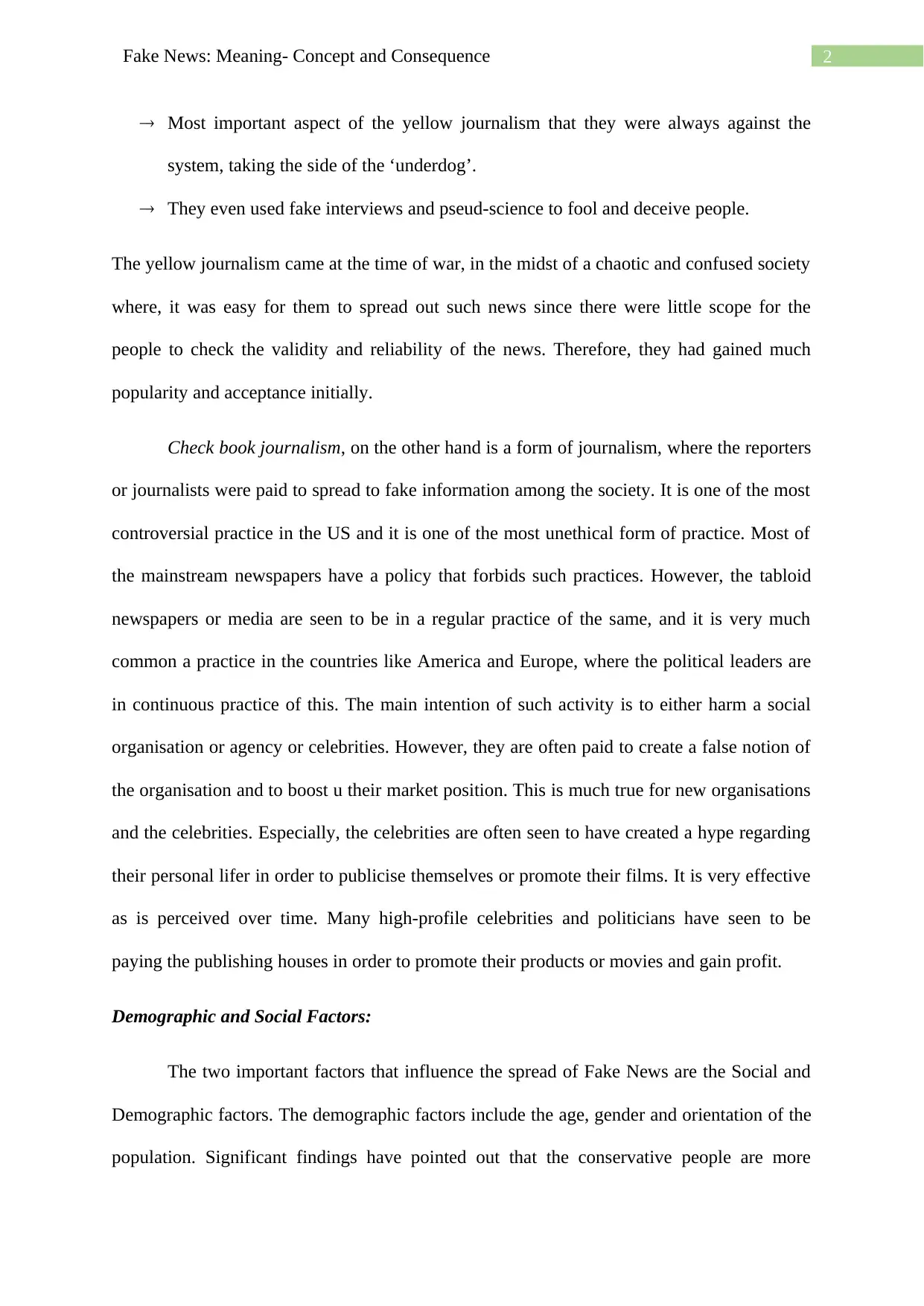
2Fake News: Meaning- Concept and Consequence
Most important aspect of the yellow journalism that they were always against the
system, taking the side of the ‘underdog’.
They even used fake interviews and pseud-science to fool and deceive people.
The yellow journalism came at the time of war, in the midst of a chaotic and confused society
where, it was easy for them to spread out such news since there were little scope for the
people to check the validity and reliability of the news. Therefore, they had gained much
popularity and acceptance initially.
Check book journalism, on the other hand is a form of journalism, where the reporters
or journalists were paid to spread to fake information among the society. It is one of the most
controversial practice in the US and it is one of the most unethical form of practice. Most of
the mainstream newspapers have a policy that forbids such practices. However, the tabloid
newspapers or media are seen to be in a regular practice of the same, and it is very much
common a practice in the countries like America and Europe, where the political leaders are
in continuous practice of this. The main intention of such activity is to either harm a social
organisation or agency or celebrities. However, they are often paid to create a false notion of
the organisation and to boost u their market position. This is much true for new organisations
and the celebrities. Especially, the celebrities are often seen to have created a hype regarding
their personal lifer in order to publicise themselves or promote their films. It is very effective
as is perceived over time. Many high-profile celebrities and politicians have seen to be
paying the publishing houses in order to promote their products or movies and gain profit.
Demographic and Social Factors:
The two important factors that influence the spread of Fake News are the Social and
Demographic factors. The demographic factors include the age, gender and orientation of the
population. Significant findings have pointed out that the conservative people are more
Most important aspect of the yellow journalism that they were always against the
system, taking the side of the ‘underdog’.
They even used fake interviews and pseud-science to fool and deceive people.
The yellow journalism came at the time of war, in the midst of a chaotic and confused society
where, it was easy for them to spread out such news since there were little scope for the
people to check the validity and reliability of the news. Therefore, they had gained much
popularity and acceptance initially.
Check book journalism, on the other hand is a form of journalism, where the reporters
or journalists were paid to spread to fake information among the society. It is one of the most
controversial practice in the US and it is one of the most unethical form of practice. Most of
the mainstream newspapers have a policy that forbids such practices. However, the tabloid
newspapers or media are seen to be in a regular practice of the same, and it is very much
common a practice in the countries like America and Europe, where the political leaders are
in continuous practice of this. The main intention of such activity is to either harm a social
organisation or agency or celebrities. However, they are often paid to create a false notion of
the organisation and to boost u their market position. This is much true for new organisations
and the celebrities. Especially, the celebrities are often seen to have created a hype regarding
their personal lifer in order to publicise themselves or promote their films. It is very effective
as is perceived over time. Many high-profile celebrities and politicians have seen to be
paying the publishing houses in order to promote their products or movies and gain profit.
Demographic and Social Factors:
The two important factors that influence the spread of Fake News are the Social and
Demographic factors. The demographic factors include the age, gender and orientation of the
population. Significant findings have pointed out that the conservative people are more
⊘ This is a preview!⊘
Do you want full access?
Subscribe today to unlock all pages.

Trusted by 1+ million students worldwide

3Fake News: Meaning- Concept and Consequence
tended to believe the fake news than the liberal people (Verma. Fleischmann and Koltai.
2018). The conservative people are not open to a lot of options and conversations and put
more trust in the knowledge gained from the visual media and print media than the
knowledge gained from the people. Therefore, it is easier for these media modes to influence
them.
Secondly, it is seen that the people with higher degree of educational attainment are
less prone to put their belief in the fake news. People with higher degree of education are
more emancipated and they have knowledge and understandings of a various concepts that
enable them not to get influenced by the fake news. The people low educational status, lack
proper knowledge and understanding, and therefore are more prone to put trust in the fake
news (Tandoc et al. 2018. pp.137-153) . Moreover, the people with sound education, have the
zest to search for the truth of the knowledge gathered through the various modes of media,
however, people with less knowledge and educational attainments, lack this kind of
orientation and get easily victimised by the fake news.
Another finding shows that the old or elderly people are more prone to believe and
spread fake news. The old people of theses days, spend more time on the internet and social
media than the youth or the teen agers. Therefore, they are more prone to believe the fake
news that are circulated and are more prone to spread them as well. A good amount of elderly
people is seen to have spent their time by watching the TV or reading the newspaper.
Therefore, since a lot of their times are spent like that, it is seen that they get more influenced
by the knowledge gained through these.
Further, it is seen that the political orientation and usage of social media also
contributes as the major reasons for believing and spreading the fake news. While political
leaning influences trust in mainstream media and scientific journals. These findings shed new
tended to believe the fake news than the liberal people (Verma. Fleischmann and Koltai.
2018). The conservative people are not open to a lot of options and conversations and put
more trust in the knowledge gained from the visual media and print media than the
knowledge gained from the people. Therefore, it is easier for these media modes to influence
them.
Secondly, it is seen that the people with higher degree of educational attainment are
less prone to put their belief in the fake news. People with higher degree of education are
more emancipated and they have knowledge and understandings of a various concepts that
enable them not to get influenced by the fake news. The people low educational status, lack
proper knowledge and understanding, and therefore are more prone to put trust in the fake
news (Tandoc et al. 2018. pp.137-153) . Moreover, the people with sound education, have the
zest to search for the truth of the knowledge gathered through the various modes of media,
however, people with less knowledge and educational attainments, lack this kind of
orientation and get easily victimised by the fake news.
Another finding shows that the old or elderly people are more prone to believe and
spread fake news. The old people of theses days, spend more time on the internet and social
media than the youth or the teen agers. Therefore, they are more prone to believe the fake
news that are circulated and are more prone to spread them as well. A good amount of elderly
people is seen to have spent their time by watching the TV or reading the newspaper.
Therefore, since a lot of their times are spent like that, it is seen that they get more influenced
by the knowledge gained through these.
Further, it is seen that the political orientation and usage of social media also
contributes as the major reasons for believing and spreading the fake news. While political
leaning influences trust in mainstream media and scientific journals. These findings shed new
Paraphrase This Document
Need a fresh take? Get an instant paraphrase of this document with our AI Paraphraser
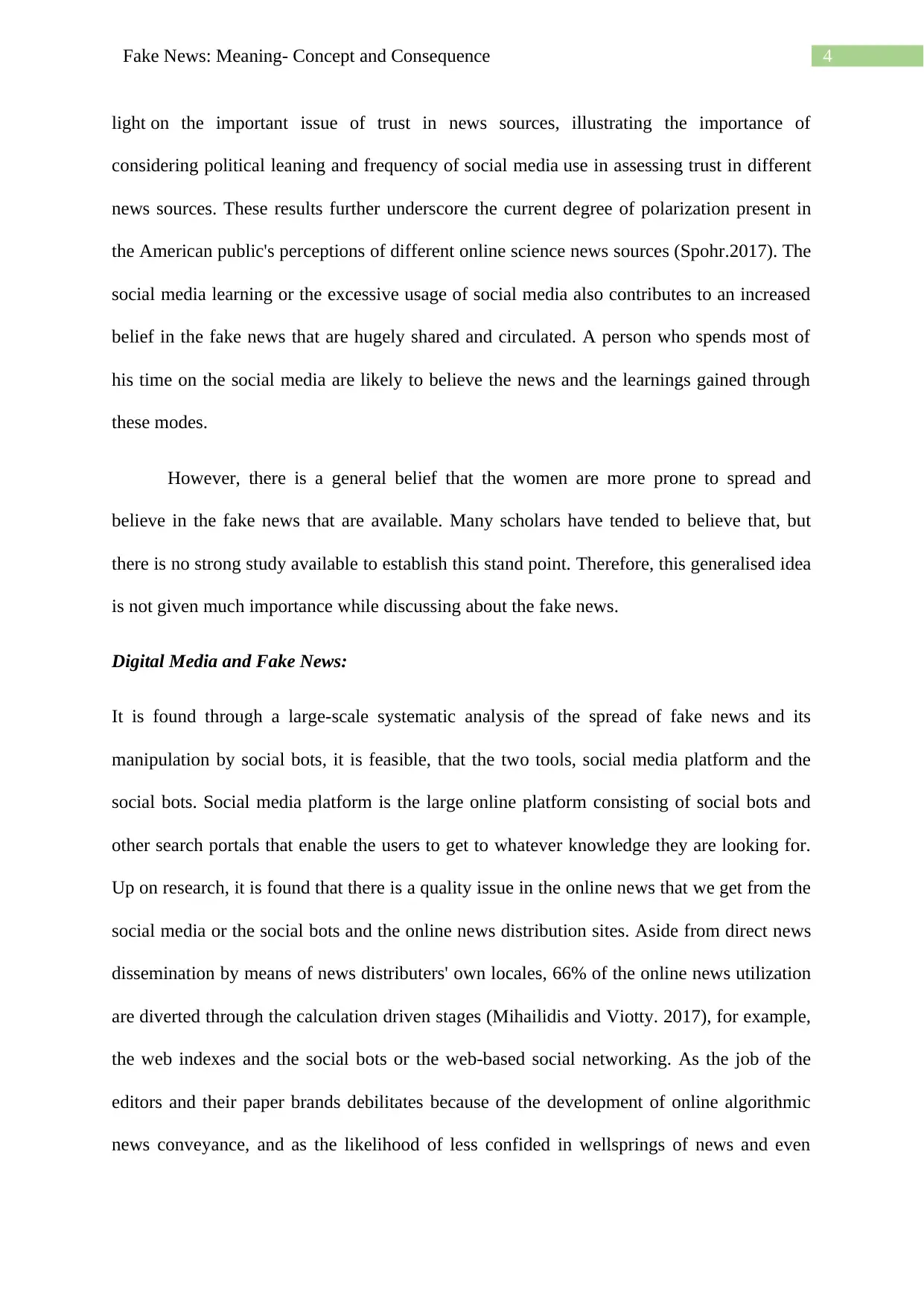
4Fake News: Meaning- Concept and Consequence
light on the important issue of trust in news sources, illustrating the importance of
considering political leaning and frequency of social media use in assessing trust in different
news sources. These results further underscore the current degree of polarization present in
the American public's perceptions of different online science news sources (Spohr.2017). The
social media learning or the excessive usage of social media also contributes to an increased
belief in the fake news that are hugely shared and circulated. A person who spends most of
his time on the social media are likely to believe the news and the learnings gained through
these modes.
However, there is a general belief that the women are more prone to spread and
believe in the fake news that are available. Many scholars have tended to believe that, but
there is no strong study available to establish this stand point. Therefore, this generalised idea
is not given much importance while discussing about the fake news.
Digital Media and Fake News:
It is found through a large-scale systematic analysis of the spread of fake news and its
manipulation by social bots, it is feasible, that the two tools, social media platform and the
social bots. Social media platform is the large online platform consisting of social bots and
other search portals that enable the users to get to whatever knowledge they are looking for.
Up on research, it is found that there is a quality issue in the online news that we get from the
social media or the social bots and the online news distribution sites. Aside from direct news
dissemination by means of news distributers' own locales, 66% of the online news utilization
are diverted through the calculation driven stages (Mihailidis and Viotty. 2017), for example,
the web indexes and the social bots or the web-based social networking. As the job of the
editors and their paper brands debilitates because of the development of online algorithmic
news conveyance, and as the likelihood of less confided in wellsprings of news and even
light on the important issue of trust in news sources, illustrating the importance of
considering political leaning and frequency of social media use in assessing trust in different
news sources. These results further underscore the current degree of polarization present in
the American public's perceptions of different online science news sources (Spohr.2017). The
social media learning or the excessive usage of social media also contributes to an increased
belief in the fake news that are hugely shared and circulated. A person who spends most of
his time on the social media are likely to believe the news and the learnings gained through
these modes.
However, there is a general belief that the women are more prone to spread and
believe in the fake news that are available. Many scholars have tended to believe that, but
there is no strong study available to establish this stand point. Therefore, this generalised idea
is not given much importance while discussing about the fake news.
Digital Media and Fake News:
It is found through a large-scale systematic analysis of the spread of fake news and its
manipulation by social bots, it is feasible, that the two tools, social media platform and the
social bots. Social media platform is the large online platform consisting of social bots and
other search portals that enable the users to get to whatever knowledge they are looking for.
Up on research, it is found that there is a quality issue in the online news that we get from the
social media or the social bots and the online news distribution sites. Aside from direct news
dissemination by means of news distributers' own locales, 66% of the online news utilization
are diverted through the calculation driven stages (Mihailidis and Viotty. 2017), for example,
the web indexes and the social bots or the web-based social networking. As the job of the
editors and their paper brands debilitates because of the development of online algorithmic
news conveyance, and as the likelihood of less confided in wellsprings of news and even
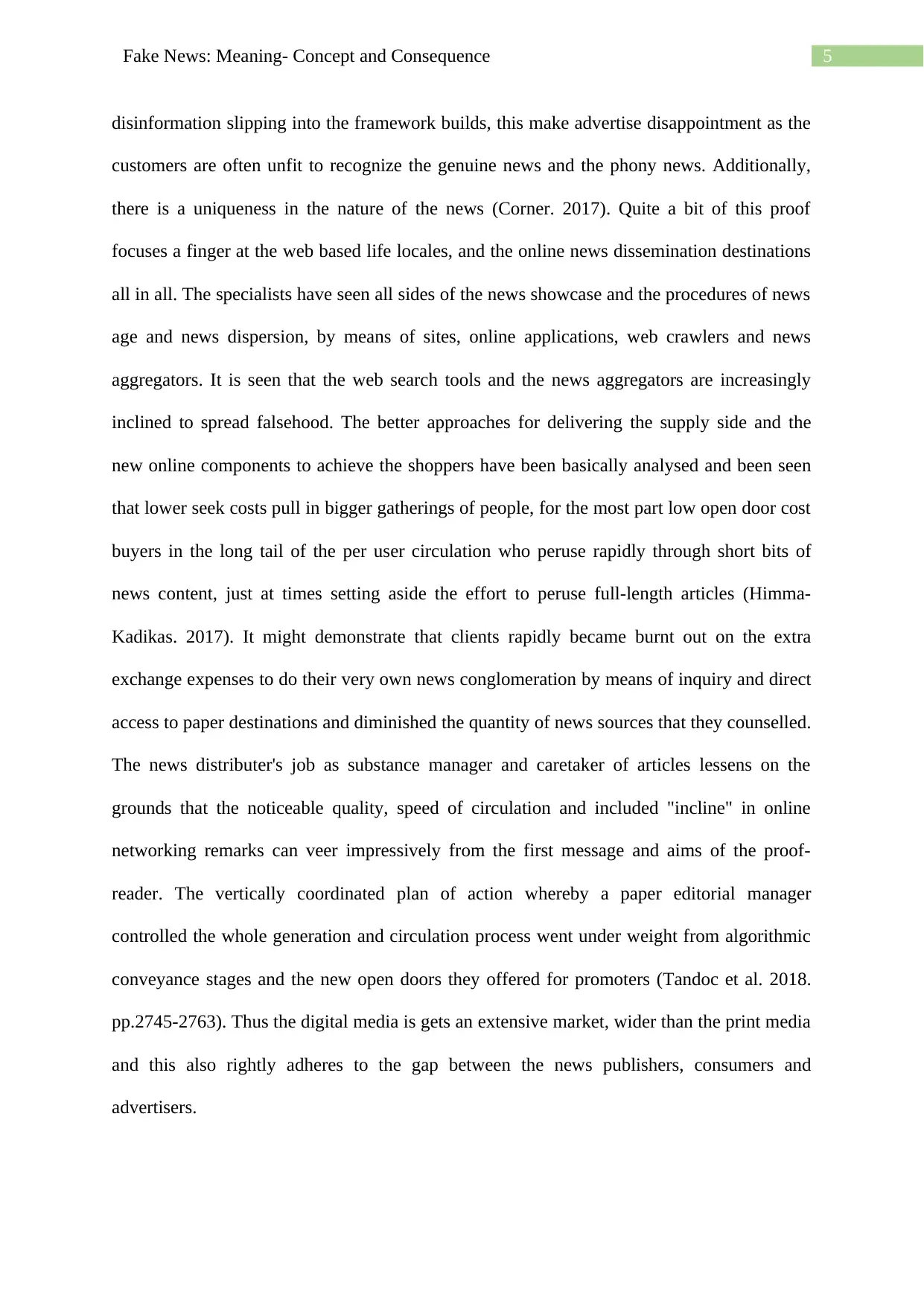
5Fake News: Meaning- Concept and Consequence
disinformation slipping into the framework builds, this make advertise disappointment as the
customers are often unfit to recognize the genuine news and the phony news. Additionally,
there is a uniqueness in the nature of the news (Corner. 2017). Quite a bit of this proof
focuses a finger at the web based life locales, and the online news dissemination destinations
all in all. The specialists have seen all sides of the news showcase and the procedures of news
age and news dispersion, by means of sites, online applications, web crawlers and news
aggregators. It is seen that the web search tools and the news aggregators are increasingly
inclined to spread falsehood. The better approaches for delivering the supply side and the
new online components to achieve the shoppers have been basically analysed and been seen
that lower seek costs pull in bigger gatherings of people, for the most part low open door cost
buyers in the long tail of the per user circulation who peruse rapidly through short bits of
news content, just at times setting aside the effort to peruse full-length articles (Himma-
Kadikas. 2017). It might demonstrate that clients rapidly became burnt out on the extra
exchange expenses to do their very own news conglomeration by means of inquiry and direct
access to paper destinations and diminished the quantity of news sources that they counselled.
The news distributer's job as substance manager and caretaker of articles lessens on the
grounds that the noticeable quality, speed of circulation and included "incline" in online
networking remarks can veer impressively from the first message and aims of the proof-
reader. The vertically coordinated plan of action whereby a paper editorial manager
controlled the whole generation and circulation process went under weight from algorithmic
conveyance stages and the new open doors they offered for promoters (Tandoc et al. 2018.
pp.2745-2763). Thus the digital media is gets an extensive market, wider than the print media
and this also rightly adheres to the gap between the news publishers, consumers and
advertisers.
disinformation slipping into the framework builds, this make advertise disappointment as the
customers are often unfit to recognize the genuine news and the phony news. Additionally,
there is a uniqueness in the nature of the news (Corner. 2017). Quite a bit of this proof
focuses a finger at the web based life locales, and the online news dissemination destinations
all in all. The specialists have seen all sides of the news showcase and the procedures of news
age and news dispersion, by means of sites, online applications, web crawlers and news
aggregators. It is seen that the web search tools and the news aggregators are increasingly
inclined to spread falsehood. The better approaches for delivering the supply side and the
new online components to achieve the shoppers have been basically analysed and been seen
that lower seek costs pull in bigger gatherings of people, for the most part low open door cost
buyers in the long tail of the per user circulation who peruse rapidly through short bits of
news content, just at times setting aside the effort to peruse full-length articles (Himma-
Kadikas. 2017). It might demonstrate that clients rapidly became burnt out on the extra
exchange expenses to do their very own news conglomeration by means of inquiry and direct
access to paper destinations and diminished the quantity of news sources that they counselled.
The news distributer's job as substance manager and caretaker of articles lessens on the
grounds that the noticeable quality, speed of circulation and included "incline" in online
networking remarks can veer impressively from the first message and aims of the proof-
reader. The vertically coordinated plan of action whereby a paper editorial manager
controlled the whole generation and circulation process went under weight from algorithmic
conveyance stages and the new open doors they offered for promoters (Tandoc et al. 2018.
pp.2745-2763). Thus the digital media is gets an extensive market, wider than the print media
and this also rightly adheres to the gap between the news publishers, consumers and
advertisers.
⊘ This is a preview!⊘
Do you want full access?
Subscribe today to unlock all pages.

Trusted by 1+ million students worldwide

6Fake News: Meaning- Concept and Consequence
A further advance in the computerized change of news dissemination by the social
bots that control the social networking sites. A social bot is a type of software that controls all
the social media accounts. The precise way a social bot repeats relies upon the informal
community, yet not at all like a customary bot, a social bot spreads by persuading different
clients that the social bot is a genuine person. If, not malevolent, most would in any event
contend that social bots are unscrupulous. All things considered, there entire purpose of
informal communication is for real people to associate. Regardless of whether a social bot
really takes information or is simply accomplished for entertainment of the maker, the truth is
that a social bot needs to trap a genuine client so as to spread. It's not as though they can draw
on their genuine associations and encounters. Social bots are most common in the Twitter and
Facebook (Jang and Jim. 2018). However, these social bots not only control the user’s
account but also controls the types of news and information that the user is getting.
Therefore, they show misinformation regarding the interest areas of the users.
Also, the social media is often seen to have been spreading fake news. Especially,
Face book and Twitter are the two most dominant social media websites that spread
misinformation. Moreover, they are often seen to have sharing news regarding the political
scenario of the country and various organisations, in order to harm their reputation and
existence (Makori. 2015). Many important persona and celebrities are also the victim of the
same. It is often seen that the social media shares upsetting or disturbing or extremely
personal pictures or news, in a distorted manner, of the eminent personalities, in order to hurt
their social positioning.
The state bodies and the government data are also seen to have often been engaged
into sharing fake news. The government bodies often, hide the actual data related to violence,
crime, educational status, agricultural status, economic status and growth indexes from their
citizens in order to keep them in a false notion. It is also reported that the government often
A further advance in the computerized change of news dissemination by the social
bots that control the social networking sites. A social bot is a type of software that controls all
the social media accounts. The precise way a social bot repeats relies upon the informal
community, yet not at all like a customary bot, a social bot spreads by persuading different
clients that the social bot is a genuine person. If, not malevolent, most would in any event
contend that social bots are unscrupulous. All things considered, there entire purpose of
informal communication is for real people to associate. Regardless of whether a social bot
really takes information or is simply accomplished for entertainment of the maker, the truth is
that a social bot needs to trap a genuine client so as to spread. It's not as though they can draw
on their genuine associations and encounters. Social bots are most common in the Twitter and
Facebook (Jang and Jim. 2018). However, these social bots not only control the user’s
account but also controls the types of news and information that the user is getting.
Therefore, they show misinformation regarding the interest areas of the users.
Also, the social media is often seen to have been spreading fake news. Especially,
Face book and Twitter are the two most dominant social media websites that spread
misinformation. Moreover, they are often seen to have sharing news regarding the political
scenario of the country and various organisations, in order to harm their reputation and
existence (Makori. 2015). Many important persona and celebrities are also the victim of the
same. It is often seen that the social media shares upsetting or disturbing or extremely
personal pictures or news, in a distorted manner, of the eminent personalities, in order to hurt
their social positioning.
The state bodies and the government data are also seen to have often been engaged
into sharing fake news. The government bodies often, hide the actual data related to violence,
crime, educational status, agricultural status, economic status and growth indexes from their
citizens in order to keep them in a false notion. It is also reported that the government often
Paraphrase This Document
Need a fresh take? Get an instant paraphrase of this document with our AI Paraphraser
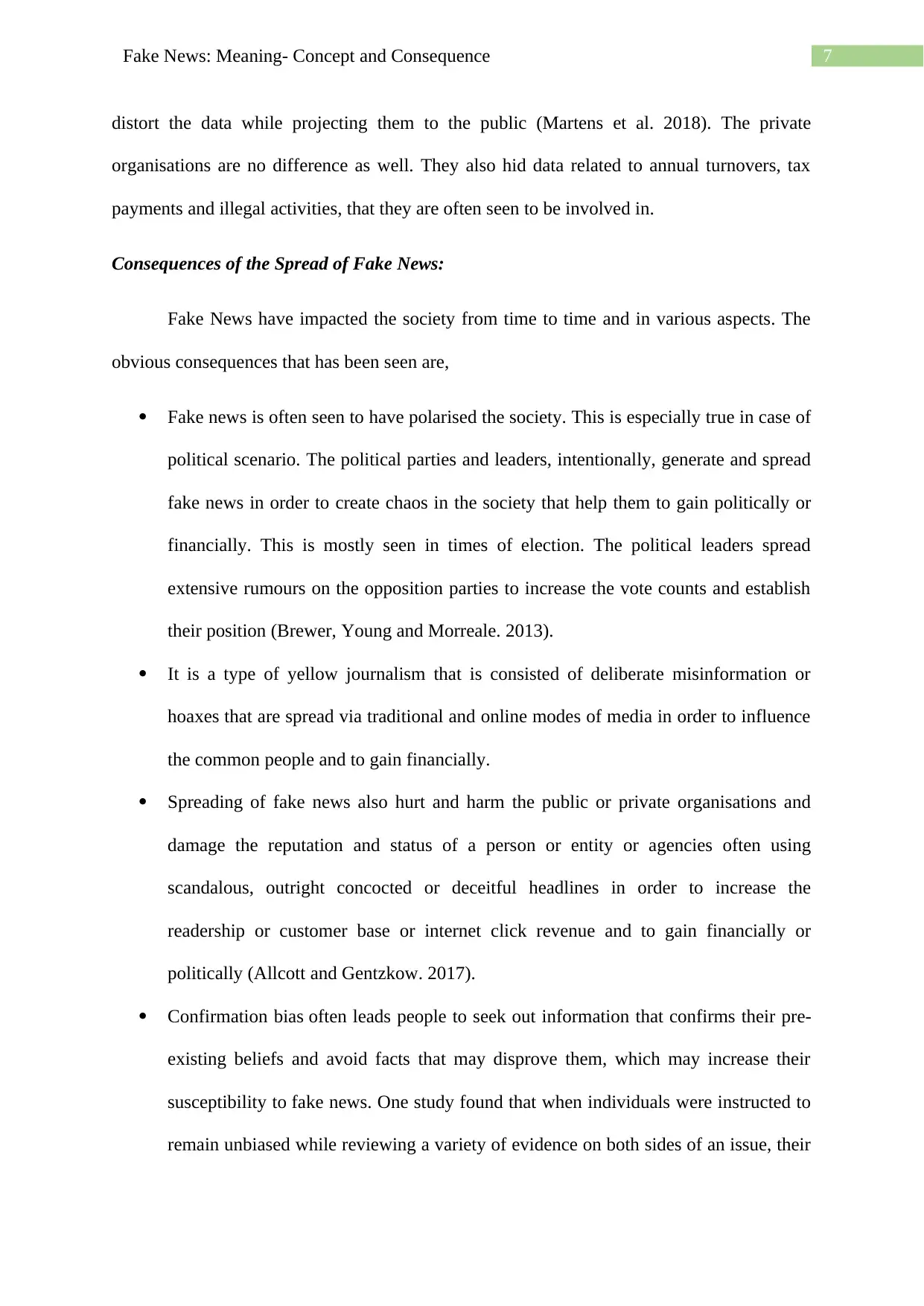
7Fake News: Meaning- Concept and Consequence
distort the data while projecting them to the public (Martens et al. 2018). The private
organisations are no difference as well. They also hid data related to annual turnovers, tax
payments and illegal activities, that they are often seen to be involved in.
Consequences of the Spread of Fake News:
Fake News have impacted the society from time to time and in various aspects. The
obvious consequences that has been seen are,
Fake news is often seen to have polarised the society. This is especially true in case of
political scenario. The political parties and leaders, intentionally, generate and spread
fake news in order to create chaos in the society that help them to gain politically or
financially. This is mostly seen in times of election. The political leaders spread
extensive rumours on the opposition parties to increase the vote counts and establish
their position (Brewer, Young and Morreale. 2013).
It is a type of yellow journalism that is consisted of deliberate misinformation or
hoaxes that are spread via traditional and online modes of media in order to influence
the common people and to gain financially.
Spreading of fake news also hurt and harm the public or private organisations and
damage the reputation and status of a person or entity or agencies often using
scandalous, outright concocted or deceitful headlines in order to increase the
readership or customer base or internet click revenue and to gain financially or
politically (Allcott and Gentzkow. 2017).
Confirmation bias often leads people to seek out information that confirms their pre-
existing beliefs and avoid facts that may disprove them, which may increase their
susceptibility to fake news. One study found that when individuals were instructed to
remain unbiased while reviewing a variety of evidence on both sides of an issue, their
distort the data while projecting them to the public (Martens et al. 2018). The private
organisations are no difference as well. They also hid data related to annual turnovers, tax
payments and illegal activities, that they are often seen to be involved in.
Consequences of the Spread of Fake News:
Fake News have impacted the society from time to time and in various aspects. The
obvious consequences that has been seen are,
Fake news is often seen to have polarised the society. This is especially true in case of
political scenario. The political parties and leaders, intentionally, generate and spread
fake news in order to create chaos in the society that help them to gain politically or
financially. This is mostly seen in times of election. The political leaders spread
extensive rumours on the opposition parties to increase the vote counts and establish
their position (Brewer, Young and Morreale. 2013).
It is a type of yellow journalism that is consisted of deliberate misinformation or
hoaxes that are spread via traditional and online modes of media in order to influence
the common people and to gain financially.
Spreading of fake news also hurt and harm the public or private organisations and
damage the reputation and status of a person or entity or agencies often using
scandalous, outright concocted or deceitful headlines in order to increase the
readership or customer base or internet click revenue and to gain financially or
politically (Allcott and Gentzkow. 2017).
Confirmation bias often leads people to seek out information that confirms their pre-
existing beliefs and avoid facts that may disprove them, which may increase their
susceptibility to fake news. One study found that when individuals were instructed to
remain unbiased while reviewing a variety of evidence on both sides of an issue, their
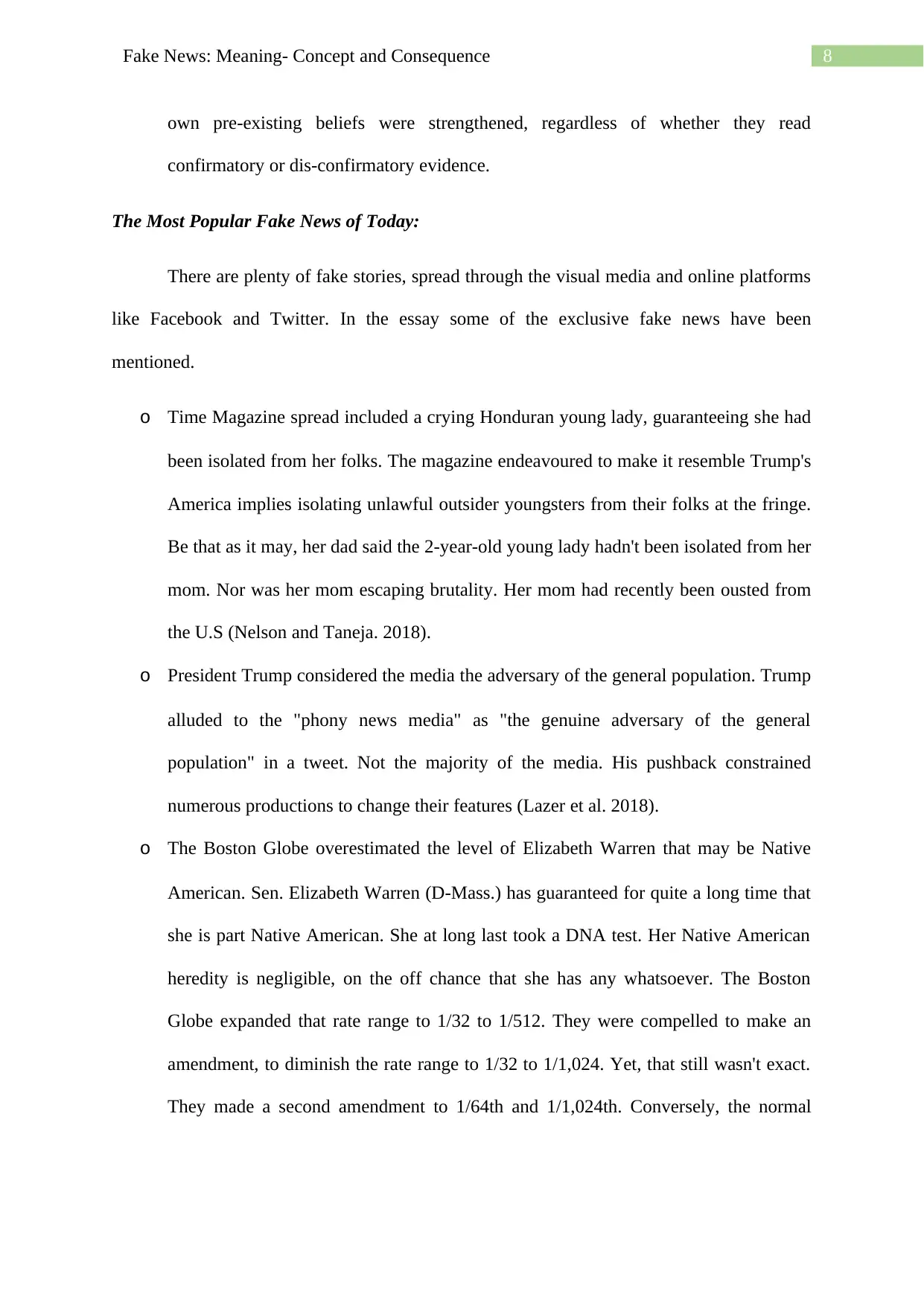
8Fake News: Meaning- Concept and Consequence
own pre-existing beliefs were strengthened, regardless of whether they read
confirmatory or dis-confirmatory evidence.
The Most Popular Fake News of Today:
There are plenty of fake stories, spread through the visual media and online platforms
like Facebook and Twitter. In the essay some of the exclusive fake news have been
mentioned.
o Time Magazine spread included a crying Honduran young lady, guaranteeing she had
been isolated from her folks. The magazine endeavoured to make it resemble Trump's
America implies isolating unlawful outsider youngsters from their folks at the fringe.
Be that as it may, her dad said the 2-year-old young lady hadn't been isolated from her
mom. Nor was her mom escaping brutality. Her mom had recently been ousted from
the U.S (Nelson and Taneja. 2018).
o President Trump considered the media the adversary of the general population. Trump
alluded to the "phony news media" as "the genuine adversary of the general
population" in a tweet. Not the majority of the media. His pushback constrained
numerous productions to change their features (Lazer et al. 2018).
o The Boston Globe overestimated the level of Elizabeth Warren that may be Native
American. Sen. Elizabeth Warren (D-Mass.) has guaranteed for quite a long time that
she is part Native American. She at long last took a DNA test. Her Native American
heredity is negligible, on the off chance that she has any whatsoever. The Boston
Globe expanded that rate range to 1/32 to 1/512. They were compelled to make an
amendment, to diminish the rate range to 1/32 to 1/1,024. Yet, that still wasn't exact.
They made a second amendment to 1/64th and 1/1,024th. Conversely, the normal
own pre-existing beliefs were strengthened, regardless of whether they read
confirmatory or dis-confirmatory evidence.
The Most Popular Fake News of Today:
There are plenty of fake stories, spread through the visual media and online platforms
like Facebook and Twitter. In the essay some of the exclusive fake news have been
mentioned.
o Time Magazine spread included a crying Honduran young lady, guaranteeing she had
been isolated from her folks. The magazine endeavoured to make it resemble Trump's
America implies isolating unlawful outsider youngsters from their folks at the fringe.
Be that as it may, her dad said the 2-year-old young lady hadn't been isolated from her
mom. Nor was her mom escaping brutality. Her mom had recently been ousted from
the U.S (Nelson and Taneja. 2018).
o President Trump considered the media the adversary of the general population. Trump
alluded to the "phony news media" as "the genuine adversary of the general
population" in a tweet. Not the majority of the media. His pushback constrained
numerous productions to change their features (Lazer et al. 2018).
o The Boston Globe overestimated the level of Elizabeth Warren that may be Native
American. Sen. Elizabeth Warren (D-Mass.) has guaranteed for quite a long time that
she is part Native American. She at long last took a DNA test. Her Native American
heredity is negligible, on the off chance that she has any whatsoever. The Boston
Globe expanded that rate range to 1/32 to 1/512. They were compelled to make an
amendment, to diminish the rate range to 1/32 to 1/1,024. Yet, that still wasn't exact.
They made a second amendment to 1/64th and 1/1,024th. Conversely, the normal
⊘ This is a preview!⊘
Do you want full access?
Subscribe today to unlock all pages.

Trusted by 1+ million students worldwide
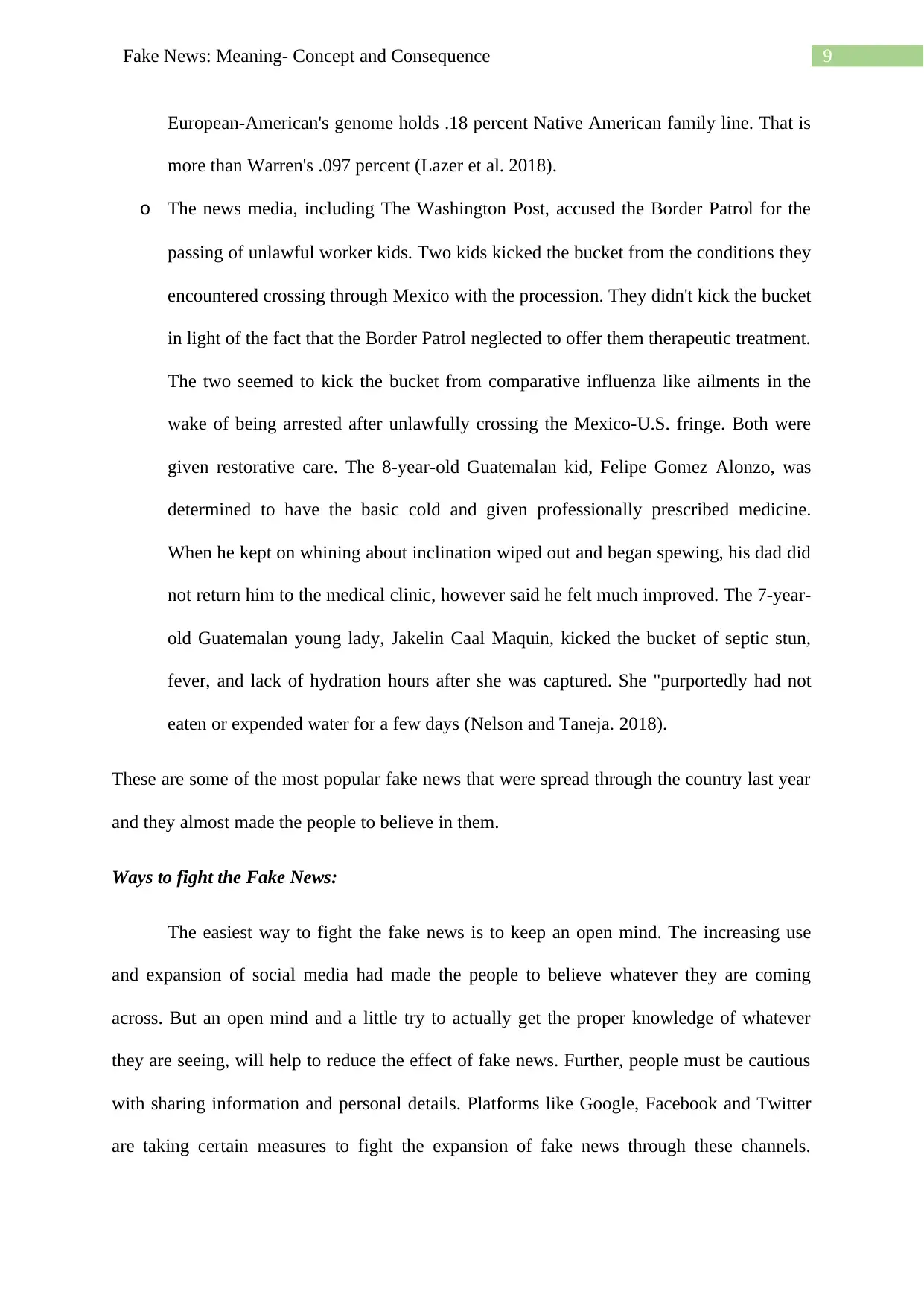
9Fake News: Meaning- Concept and Consequence
European-American's genome holds .18 percent Native American family line. That is
more than Warren's .097 percent (Lazer et al. 2018).
o The news media, including The Washington Post, accused the Border Patrol for the
passing of unlawful worker kids. Two kids kicked the bucket from the conditions they
encountered crossing through Mexico with the procession. They didn't kick the bucket
in light of the fact that the Border Patrol neglected to offer them therapeutic treatment.
The two seemed to kick the bucket from comparative influenza like ailments in the
wake of being arrested after unlawfully crossing the Mexico-U.S. fringe. Both were
given restorative care. The 8-year-old Guatemalan kid, Felipe Gomez Alonzo, was
determined to have the basic cold and given professionally prescribed medicine.
When he kept on whining about inclination wiped out and began spewing, his dad did
not return him to the medical clinic, however said he felt much improved. The 7-year-
old Guatemalan young lady, Jakelin Caal Maquin, kicked the bucket of septic stun,
fever, and lack of hydration hours after she was captured. She "purportedly had not
eaten or expended water for a few days (Nelson and Taneja. 2018).
These are some of the most popular fake news that were spread through the country last year
and they almost made the people to believe in them.
Ways to fight the Fake News:
The easiest way to fight the fake news is to keep an open mind. The increasing use
and expansion of social media had made the people to believe whatever they are coming
across. But an open mind and a little try to actually get the proper knowledge of whatever
they are seeing, will help to reduce the effect of fake news. Further, people must be cautious
with sharing information and personal details. Platforms like Google, Facebook and Twitter
are taking certain measures to fight the expansion of fake news through these channels.
European-American's genome holds .18 percent Native American family line. That is
more than Warren's .097 percent (Lazer et al. 2018).
o The news media, including The Washington Post, accused the Border Patrol for the
passing of unlawful worker kids. Two kids kicked the bucket from the conditions they
encountered crossing through Mexico with the procession. They didn't kick the bucket
in light of the fact that the Border Patrol neglected to offer them therapeutic treatment.
The two seemed to kick the bucket from comparative influenza like ailments in the
wake of being arrested after unlawfully crossing the Mexico-U.S. fringe. Both were
given restorative care. The 8-year-old Guatemalan kid, Felipe Gomez Alonzo, was
determined to have the basic cold and given professionally prescribed medicine.
When he kept on whining about inclination wiped out and began spewing, his dad did
not return him to the medical clinic, however said he felt much improved. The 7-year-
old Guatemalan young lady, Jakelin Caal Maquin, kicked the bucket of septic stun,
fever, and lack of hydration hours after she was captured. She "purportedly had not
eaten or expended water for a few days (Nelson and Taneja. 2018).
These are some of the most popular fake news that were spread through the country last year
and they almost made the people to believe in them.
Ways to fight the Fake News:
The easiest way to fight the fake news is to keep an open mind. The increasing use
and expansion of social media had made the people to believe whatever they are coming
across. But an open mind and a little try to actually get the proper knowledge of whatever
they are seeing, will help to reduce the effect of fake news. Further, people must be cautious
with sharing information and personal details. Platforms like Google, Facebook and Twitter
are taking certain measures to fight the expansion of fake news through these channels.
Paraphrase This Document
Need a fresh take? Get an instant paraphrase of this document with our AI Paraphraser
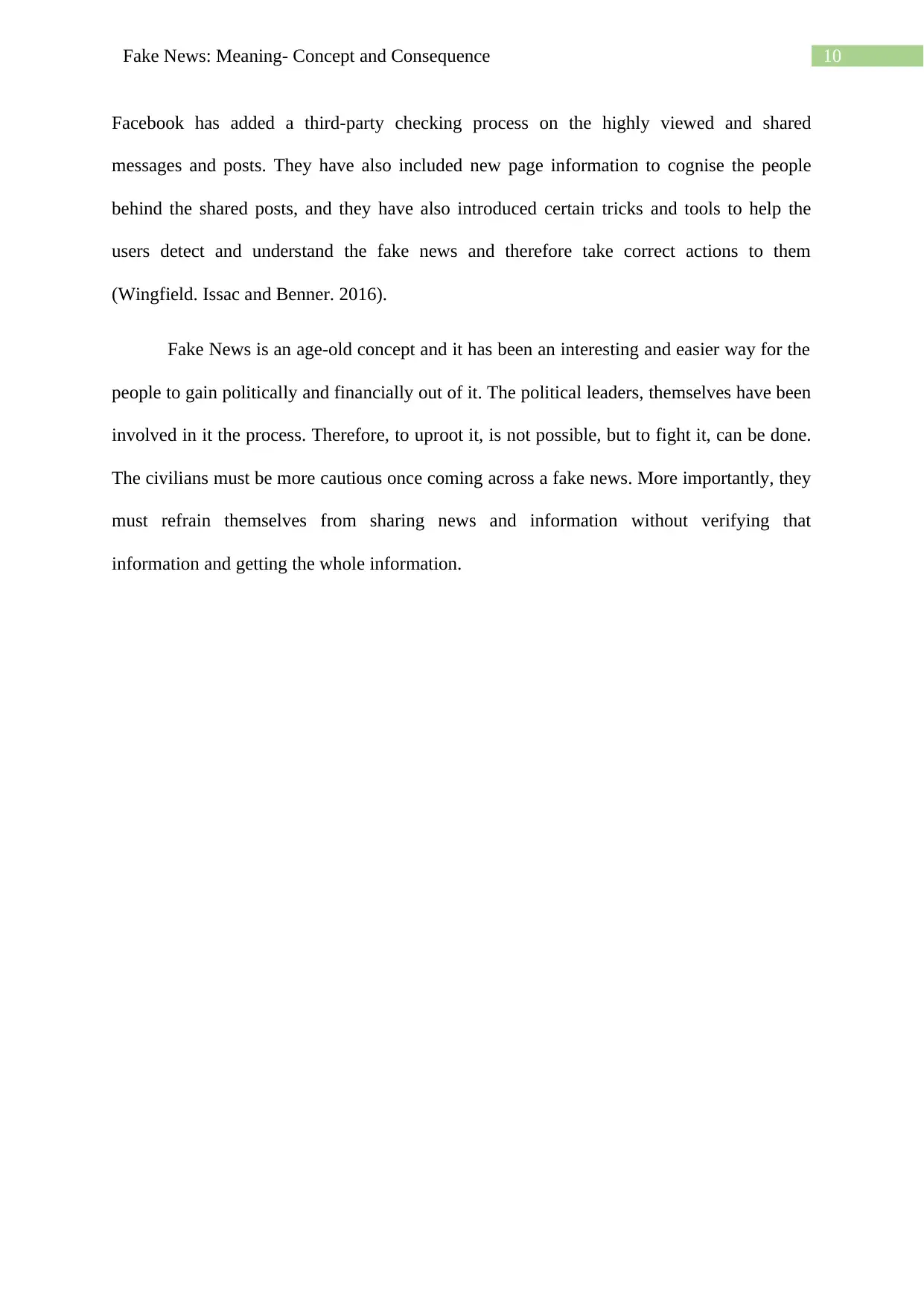
10Fake News: Meaning- Concept and Consequence
Facebook has added a third-party checking process on the highly viewed and shared
messages and posts. They have also included new page information to cognise the people
behind the shared posts, and they have also introduced certain tricks and tools to help the
users detect and understand the fake news and therefore take correct actions to them
(Wingfield. Issac and Benner. 2016).
Fake News is an age-old concept and it has been an interesting and easier way for the
people to gain politically and financially out of it. The political leaders, themselves have been
involved in it the process. Therefore, to uproot it, is not possible, but to fight it, can be done.
The civilians must be more cautious once coming across a fake news. More importantly, they
must refrain themselves from sharing news and information without verifying that
information and getting the whole information.
Facebook has added a third-party checking process on the highly viewed and shared
messages and posts. They have also included new page information to cognise the people
behind the shared posts, and they have also introduced certain tricks and tools to help the
users detect and understand the fake news and therefore take correct actions to them
(Wingfield. Issac and Benner. 2016).
Fake News is an age-old concept and it has been an interesting and easier way for the
people to gain politically and financially out of it. The political leaders, themselves have been
involved in it the process. Therefore, to uproot it, is not possible, but to fight it, can be done.
The civilians must be more cautious once coming across a fake news. More importantly, they
must refrain themselves from sharing news and information without verifying that
information and getting the whole information.

11Fake News: Meaning- Concept and Consequence
References:
Allcott, H. and Gentzkow, M., 2017. Social media and fake news in the 2016
election. Journal of economic perspectives, 31(2), pp.211-36.
Brewer, P.R., Young, D.G. and Morreale, M., 2013. The impact of real news about “fake
news”: Intertextual processes and political satire. International Journal of Public Opinion
Research, 25(3), pp.323-343.
Corner, J., 2017. Fake news, post-truth and media–political change.
Cunha, E., Magno, G., Caetano, J., Teixeira, D. and Almeida, V., 2018, September. Fake
news as we feel it: perception and conceptualization of the term “fake news” in the media.
In International Conference on Social Informatics (pp. 151-166). Springer, Cham.
Himma-Kadakas, M., 2017. Alternative facts and fake news entering journalistic content
production cycle. Cosmopolitan Civil Societies: An Interdisciplinary Journal, 9(2), pp.25-40.
Jang, S.M. and Kim, J.K., 2018. Third person effects of fake news: Fake news regulation and
media literacy interventions. Computers in Human Behavior, 80, pp.295-302.
Lazer, D.M., Baum, M.A., Benkler, Y., Berinsky, A.J., Greenhill, K.M., Menczer, F.,
Metzger, M.J., Nyhan, B., Pennycook, G., Rothschild, D. and Schudson, M., 2018. The
science of fake news. Science, 359(6380), pp.1094-1096.
References:
Allcott, H. and Gentzkow, M., 2017. Social media and fake news in the 2016
election. Journal of economic perspectives, 31(2), pp.211-36.
Brewer, P.R., Young, D.G. and Morreale, M., 2013. The impact of real news about “fake
news”: Intertextual processes and political satire. International Journal of Public Opinion
Research, 25(3), pp.323-343.
Corner, J., 2017. Fake news, post-truth and media–political change.
Cunha, E., Magno, G., Caetano, J., Teixeira, D. and Almeida, V., 2018, September. Fake
news as we feel it: perception and conceptualization of the term “fake news” in the media.
In International Conference on Social Informatics (pp. 151-166). Springer, Cham.
Himma-Kadakas, M., 2017. Alternative facts and fake news entering journalistic content
production cycle. Cosmopolitan Civil Societies: An Interdisciplinary Journal, 9(2), pp.25-40.
Jang, S.M. and Kim, J.K., 2018. Third person effects of fake news: Fake news regulation and
media literacy interventions. Computers in Human Behavior, 80, pp.295-302.
Lazer, D.M., Baum, M.A., Benkler, Y., Berinsky, A.J., Greenhill, K.M., Menczer, F.,
Metzger, M.J., Nyhan, B., Pennycook, G., Rothschild, D. and Schudson, M., 2018. The
science of fake news. Science, 359(6380), pp.1094-1096.
⊘ This is a preview!⊘
Do you want full access?
Subscribe today to unlock all pages.

Trusted by 1+ million students worldwide
1 out of 14
Related Documents
Your All-in-One AI-Powered Toolkit for Academic Success.
+13062052269
info@desklib.com
Available 24*7 on WhatsApp / Email
![[object Object]](/_next/static/media/star-bottom.7253800d.svg)
Unlock your academic potential
Copyright © 2020–2025 A2Z Services. All Rights Reserved. Developed and managed by ZUCOL.





